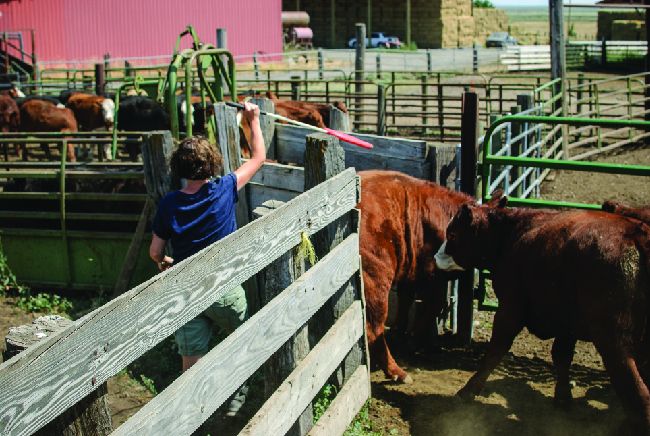It’s often the case that one step in a multistep reaction mechanism is significantly slower than the others. Because a reaction cannot proceed faster than its slowest step, this step will limit the rate at which the overall reaction occurs. The slowest step is therefore called the rate-limiting step (or rate-determining step) of the reaction.

As described earlier, rate laws may be derived directly from the chemical equations for elementary reactions. This is not the case, however, for ordinary chemical reactions. The balanced equations most often encountered represent the overall change for some chemical system, and very often this is the result of some multistep reaction mechanisms. In every case, the rate law must be determined from experimental data and the reaction mechanism subsequently deduced from the rate law (and sometimes from other data). The reaction of NO2 and CO provides an illustrative example:
$$NO_2(g)+CO(g)⟶CO_2(g)+NO(g)$$
For temperatures above 225 °C, the rate law has been found to be:
$$rate=k[NO_2][CO]$$
The reaction is first order with respect to NO2 and first-order with respect to CO. This is consistent with a single-step bimolecular mechanism and it is possible that this is the mechanism for this reaction at high temperatures.
At temperatures below 225 °C, the reaction is described by a rate law that is second order with respect to NO2:
$$rate=k[NO_2]^2$$
This rate law is not consistent with the single-step mechanism, but is consistent with the following two-step mechanism:
$$NO_2(g)+NO_2(g)⟶NO_3(g)+NO(g)\quad (slow)$$
$$NO_3(g)+CO(g)⟶NO_2(g)+CO_2(g)\quad (fast)$$
The rate-determining (slower) step gives a rate law showing second-order dependence on the NO2 concentration, and the sum of the two equations gives the net overall reaction.
In general, when the rate-determining (slower) step is the first step in a mechanism, the rate law for the overall reaction is the same as the rate law for this step. However, when the rate-determining step is preceded by a step involving a rapidly reversible reaction the rate law for the overall reaction may be more difficult to derive, since the rate law built from the elementary step may include intermediate species, which should not appear in the final rate law.
Deriving rate laws for fast-step-first reactions is not generally covered as a part of CHEM 203 or 209. However, if you wish to see how it would be done (and will be done in upper-year CHEM courses), you can expand the section below.
Click here to explore the steady state approximation.
As discussed in several chapters of this text, a reversible reaction is at equilibrium when the rates of the forward and reverse processes are equal. Consider the reversible elementary reaction in which NO dimerizes to yield an intermediate species N2O2. When this reaction is at equilibrium: $$NO+NO⇌N_2O_2$$ $$rate_{\text{forward}}=rate_{\text{reverse}}$$ $$k_1[NO]^2=k_{−1}[N_2O_2]$$ This expression may be rearranged to express the concentration of the intermediate in terms of the reactant NO: $$\left(\frac{k_1[NO]^2}{k_{−1}}\right)=[N_2O_2]$$ Since intermediate species concentrations are not used in formulating rate laws for overall reactions, this approach is sometimes necessary, as illustrated in the following example exercise.
When the first step of a reaction mechanism is fast and a later one is the rate determining step, we cannot simply take the reactants from that slow step to make the rate law (they are not the reactants of the overall reaction). We must do a bit of rearranging to find the rate law in this case.
Deriving a Rate Law from a Reaction Mechanism
The two-step mechanism below has been proposed for a reaction between nitrogen monoxide and molecular chlorine: $$Step\;1:\;NO(g)+Cl_2(g)⇌NOCl_2(g)\qquad \text{fast}$$ $$Step\;2:NOCl_2(g)+NO(g)⟶2NOCl(g)\qquad \text{slow}$$ Use this mechanism to derive the equation and predicted rate law for the overall reaction.
Solution:
The equation for the overall reaction is obtained by adding the two elementary reactions: $$2NO(g)+Cl_2(g)⇌2NOCl(g)$$ To derive a rate law from this mechanism, first write rates laws for each of the two steps. $$rate_1=k_1[NO][Cl_2]\;\text{for the forward reaction of step 1}$$ $$rate_{−1}=k_{−1}[NOCl_2]\;\text{for the reverse reaction of step 1}$$ $$rate_2=k_2[NOCl_2][NO]\;\text{for step 2}$$ Step 2 is the rate-determining step, and so the rate law for the overall reaction should be the same as for this step. However, the step 2 rate law, as written, contains an intermediate species concentration, [NOCl2]. To remedy this, use the first step’s rate laws to derive an expression for the intermediate concentration in terms of the reactant concentrations.
Assuming step 1 is at equilibrium: $$rate_1=rate_{−1}$$ $$ k_1[NO][Cl_2]=k_{−1}[NOCl_2]$$ $$ [NOCl_2]=\left(\frac{k_1}{k_{−1}}\right)[NO][Cl_2]$$ Substituting this expression into the rate law for step 2 yields: $$rate_2=rate_{overall}=\left(\frac{k_2k_1}{k_{−1}}\right)[NO]^2[Cl_2]$$
Check Your Learning
The first step of a proposed multistep mechanism is:
$$F_2(g)⇌2F(g)\quad fast$$
Derive the equation relating atomic fluorine concentration to molecular fluorine concentration.
$$[F]=\left(\frac{k_1[F_2]}{k_{−1}}\right)^{1/2}$$Answer: